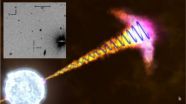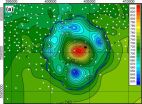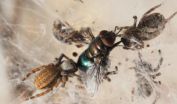(Press-News.org) This news release is available in Spanish.
The work, which has had the participation of the Ikerbasque researcher Javier Gorosabal, co-director of the Associated Unit with the Institute of Astrophysics of Andalusia/CSIC-UPV/EHU, has been published in the prestigious journal Nature.
There is no other event in the cosmos that can compete in terms of energy and intensity with stellar explosions on the outer reaches of the universe and which are known as LGRBs (Long Gamma-Ray Bursts): in just one second a single GRB can emit as many as hundreds of stars like the Sun during its 10,000-million-year-lifetime.
For the last decade astrophysicists have been in possession of strong evidence that LGRBs occur when the so-called massive stars burst; these are huge stars with masses of up to hundreds of times bigger than that of the Sun and which, moreover, spin rapidly on a rotation axis.
As these stars are massive and spin, they do not explode like a normal star, which does so radially, as a ball does when it deflates, for example. The implosion of these huge stars would produce, according to theoretical models, a huge spinning top, which would turn in the way that water rotates down the plughole of a basin, until a black hole is finally formed. The energy given off by this gigantic explosion would be emitted in two jets displaying a high level of energy and which would be aligned with the rotation axis of the dying star.
What is more, all these stars have magnetic fields. And these are intensified further if they rotate rapidly, as in the case of the LGRBs. So during the internal collapse of the star towards the central black hole, the magnetic fields of the star would also swirl around the star's rotation axis. And during the collapse of the star, a powerful "magnetic geyser" would be produced and be ejected from the environment of the black hole that is being formed; the effects of this can be felt at distances of billions of kilometres.
This complex scenario led one to predict that the light emitted during the explosion of the star must have been circularly polarized as if it were a screw. And that is what, for the first time, the authors have detected in Chile: a circularly polarized light that is the direct consequence of a black hole "recently" created on the outer reaches of the Universe and which has been confirmed by the theoretical model. What is more, an optical circular polarization to such a high degree had never been detected, and nor had one been detected in such a distant source. All this indicates that the GRB121024A is an extraordinary event.
The Associated Unit
The Planetary Sciences Group of the UPV/EHU-University of the Basque Country and Ikerbasque have participated in this discovery through the Associated Unit that the Institute of Astrophysics of Andalusia (IAA), which belongs to the Spanish National Research Council (CSIC), set up under the auspices of Euskampus at the Faculty of Engineering (ETSI, Bilbao). Among many other advantages, this partnership is an added benefit enabling the Associated Unit to participate in large international consortia like the one scientifically exploiting the VLT. The Associated Unit is jointly led by the UPV/EHU professor Agustín Sánchez Lavega and by Javier Gorosabel, scientific researcher of the CSIC and Ikerbasque Research Professor at the ETSI.
The VLT is one of the largest and best equipped telescopes in the world; it makes use of the exceptional astronomical observation conditions of the Atacama desert. That is why the use of the VLT is very limited and is regulated by a highly competitive process in which every six months an international committee selects the best proposals for observation submitted. So the only way to access these technologically state-of-the-art facilities is by means of powerful international consortia. 27 institutions belonging to 13 countries have participated in the study published by the prestigious journal Nature.
INFORMATION:
Reference:
K. Wiersema, S. Covino, K. Toma, A.J. van der Horst, K. Varela, M. Min, J. Greiner, R.L.C. Starling, N.R. Tanvir, R.A.M.J. Wijers, S. Campana, P.A. Curra, Y. Fan, J.P.U. Fynbo, J. Gorosabel, A. Gomboc, D. Götz, J. Hjorth, Z.P. Jin, S. Kobayashi, C. Kouveliotou, C. Mundell, P.T.O'Brien, E. Pian, A. Rowlinson, D.M. Russell, R. Salvaterra, S. Di Serego Alighieri, G. Tagliafferri, S.D. Vergani, J. Eliott, C. Fariña, O.E. Hartoog, R. Karjalainen, S. Klose, F. Knust, A.J. Levan, P. Schady, V. Sudilovsky, & R. Willingale. "Circular Polarization in the optical afterglow of GRB121024A". Nature, 2014, DOI 10.1038/nature13237.
Clues about black hole formation
A circular light coming from a recently created black hole has been detected for the first time
2014-05-07
ELSE PRESS RELEASES FROM THIS DATE:
How businesses can maximize revenue when introducing new products
2014-05-07
BUFFALO, N.Y. — Companies should use existing brand names and add new, sub-brand names to maximize revenue when introducing new products to market, according to a new study from the University at Buffalo School of Management.
Forthcoming in Management Science, the study notes a proliferation of new products in the consumer packaged-goods market each year. For example, U.S. manufacturers introduced more than 150,000 new products in 2010 alone. Of these, more than 90 percent were extensions of existing brand-name products.
"These new products can be line extensions, like ...
Regular doctor visits may greatly diminish skin cancer deaths
2014-05-07
VIDEO:
Melody Eide, M.D., M.P.H., a Henry Ford Hospital dermatologist and the study's lead author, says regular visits to the doctor may lead to significant reductions in melanoma mortality....
Click here for more information.
DETROIT – The risk of dying from the most dangerous type of skin cancer is significantly reduced with regular doctor visits, according to a Henry Ford Hospital study.
This is believed to be the first study of its kind to link melanoma mortality with ...
For slumbering diabetics, a way to detect low blood sugar and stop insulin delivery
2014-05-07
STANFORD, Calif. — New research could soon make it easier for people with type-1 diabetes to get a safe night's sleep, says a Stanford University School of Medicine scientist who led the study.
In a large trial conducted in patients' homes in the United States and Canada, scientists demonstrated that they could predict and prevent dangerously low overnight blood sugars in adolescents and adults with type-1 diabetes.
Very low blood-sugar levels can cause seizures or even, in rare cases, death. People with type-1 diabetes often sense warning signs of low blood sugar when ...
Ancient crater points to massive meteorite strike
2014-05-07
EDMONTON—The discovery of an ancient ring-like structure in southern Alberta suggests the area was struck by a meteorite large enough to leave an eight-kilometre-wide crater, producing an explosion strong enough to destroy present-day Calgary, say researchers from the Alberta Geological Survey and University of Alberta.
The first hints about the impact site near the southern Alberta hamlet of Bow City were discovered by a geologist with the Alberta Geological Survey and studied by a U of A team led by Doug Schmitt, Canada Research Chair in Rock Physics.
Time and glaciers ...
Mapping the spider genome
2014-05-07
The fact that the eight-legged creepy spider in some ways resembles humans is one of the surprising conclusions after researchers at Aarhus University and the Beijing Genomics Institute (BGI) succeeded in sequencing its genome.
However, it is more a discovery on an awesome scale. The sequencing has far greater significance for our future understanding of the spider's special properties.
"In brief, we've acquired a tool for everyone interested in spiders," say Kristian W. Sanggaard and Jesper S. Bechsgaard, Aarhus University. Together with Xiaodong Fang, BGI, they are ...
Neural states affect learning
2014-05-07
Theta-band activity in hippocampus after an event seems to be crucial for learning. A study at the University of Jyväskylä also proved that the absence of theta facilitated learning a simple task while training during theta had no effect on learning.
Hippocampus is a brain structure that has a critical role in mammalian learning. The identification of different hippocampal states is based on the oscillatory properties of electrophysiological activity. Traditionally, rhythmic slow activity, theta, has been linked to attention, whereas transient bursts of synchronised neuronal ...
Third US National Climate Assessment reports our ecosystems are already changing
2014-05-07
The US Global Change Research Program released its Third National Climate Assessment (NCA) of the impacts of climate change on biodiversity and ecosystems this Tuesday, May 6. The NCA is the most comprehensive peer-reviewed analysis of climate change's impacts in the United States, informing Americans about the effects of climate change in their backyards.
"As an ecologist, you can't escape the effects of climate change on natural resources. We're observing climate impacts in nearly all natural and managed ecosystems," said Ecological Society of America President Jill ...
Breastfeeding promotes the growth of beneficial bacteria in the gut
2014-05-07
A number of studies have shown that breastfed babies grow slightly slower and are slightly slimmer than children who are fed with infant formula. Children who are breastfed also have a slightly lower incidence of obesity, allergies, diabetes and inflammatory bowel disease later in life. According to a new study by the National Food Institute and the University of Copenhagen this may be due to the fact that breastfeeding promotes the development of beneficial bacteria in the baby's gut.
"We have become increasingly aware of how crucially important a healthy gut microbial ...
Nanoscale heat flow predictions
2014-05-07
Physicists are now designing novel materials with physical properties tailored to meet specific energy consumption needs. Before these so-called materials-by-design can be applied, it is essential to understand their characteristics, such as heat flow. Now, a team of Italian physicists has developed a predictive theoretical model for heat flux in these materials, using atom-scale calculations. The research, carried out by Claudio Melis and colleagues from the University of Cagliary, Italy, is published in EPJ B. Their findings could have implications for optimising the ...
Researchers use DNA to build tool that may literally shine light on cancer
2014-05-07
Bioengineers at the University of Rome Tor Vergata and the University of Montreal have used DNA to develop a tool that detects and reacts to chemical changes caused by cancer cells and that may one day be used to deliver drugs to tumor cells.
The researchers' nanosensor measures pH variations at the nanoscale – how acidic (a higher pH level) or alkaline (a lower pH level) it is. Many biomolecules, such as enzymes and proteins, are strongly regulated by small pH changes. These changes affect in turn biological activities such as enzyme catalysis, protein assembly, membrane ...
LAST 30 PRESS RELEASES:
Weaving secondary battery electrodes with fibers and tying them like ropes for both durability and performance
Using social media may impair children’s attention
Science briefing: An update on GLP-1 drugs for obesity
Lower doses of immunotherapy for skin cancer give better results
Why didn’t the senior citizen cross the road? Slower crossings may help people with reduced mobility
ASH 2025: Study suggests that a virtual program focusing on diet and exercise can help reduce side effects of lymphoma treatment
A sound defense: Noisy pupae puff away potential predators
Azacitidine–venetoclax combination outperforms standard care in acute myeloid leukemia patients eligible for intensive chemotherapy
Adding epcoritamab to standard second-line therapy improves follicular lymphoma outcomes
New findings support a chemo-free approach for treating Ph+ ALL
Non-covalent btki pirtobrutinib shows promise as frontline therapy for CLL/SLL
University of Cincinnati experts present research at annual hematology event
ASH 2025: Antibody therapy eradicates traces of multiple myeloma in preliminary trial
ASH 2025: AI uncovers how DNA architecture failures trigger blood cancer
ASH 2025: New study shows that patients can safely receive stem cell transplants from mismatched, unrelated donors
Protective regimen allows successful stem cell transplant even without close genetic match between donor and recipient
Continuous and fixed-duration treatments result in similar outcomes for CLL
Measurable residual disease shows strong potential as an early indicator of survival in patients with acute myeloid leukemia
Chemotherapy and radiation are comparable as pre-transplant conditioning for patients with b-acute lymphoblastic leukemia who have no measurable residual disease
Roughly one-third of families with children being treated for leukemia struggle to pay living expenses
Quality improvement project results in increased screening and treatment for iron deficiency in pregnancy
IV iron improves survival, increases hemoglobin in hospitalized patients with iron-deficiency anemia and an acute infection
Black patients with acute myeloid leukemia are younger at diagnosis and experience poorer survival outcomes than White patients
Emergency departments fall short on delivering timely treatment for sickle cell pain
Study shows no clear evidence of harm from hydroxyurea use during pregnancy
Long-term outlook is positive for most after hematopoietic cell transplant for sickle cell disease
Study offers real-world data on commercial implementation of gene therapies for sickle cell disease and beta thalassemia
Early results suggest exa-cel gene therapy works well in children
NTIDE: Disability employment holds steady after data hiatus
Social lives of viruses affect antiviral resistance
[Press-News.org] Clues about black hole formationA circular light coming from a recently created black hole has been detected for the first time




